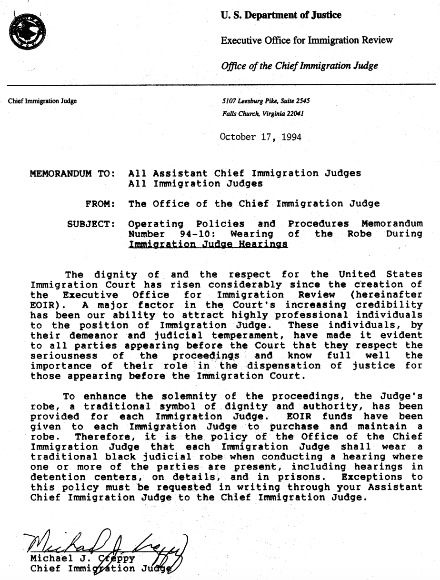EOIR Guidance on the Meaning of the Judicial Robe Worn by Immigration Judges

- Introduction
- OPPM 94-10
- What is the Purpose of the Immigration Judge's Robe?
- When Are Immigration Judges Required to Wear the Robe?
- Exceptions to the Requirement
- Conclusion
Introduction
On October 17, 1994, then-Chief Immigration Judge Michael J. Crappy issued “Operating Policies and Procedures Memorandum Number 94-10: Wearing of the Robe During Immigration Judge Hearings” (“OPPM 94-10”) [PDF version]. OPPM 94-10 details the significance of the robe worn by an immigration judge during proceedings and the policies for the exception to the requirement that he or she wear a robe. OPPM 94-10 was slightly modified over two decades later by “Operating Policies and Procedures Memorandum 17-03: Guidelines for Immigration Court Cases Involving Juveniles, Including Unaccompanied Alien Children” (“OPPM 17-03”) [PDF version]. OPPM 17-03 modified the rules for removing the immigration judge's role in order to better put juvenile respondents or witnesses at ease. We discuss OPPM 17-03 in detail in a separate article [see article].
In this article, we will examine OPPM 94-10 in detail, including how it was subsequently modified by OPPM 17-03.
OPPM 94-10
For your reference, the following is OPPM 94-10 in its entirety:
[Click image to view full size]
What is the Purpose of the Immigration Judge's Robe?
The Executive Office for Immigration Review (EOIR) was created on January 9, 1983. OPPM 94-10, which was issued just over a decade later, cited to the creation of the EOIR as an event which increased “[t]he dignity and respect for the United States Immigration Court…” Furthermore, it took the position that immigration courts were able to “attract highly professional individuals to the position of Immigration Judge.”
OPPM 94-10 explained that robes were provided for each immigration judge in order to “enhance the solemnity of the proceedings…”
Stepping away from OPPM 94-10 for a moment, it is worth addressing that some readers may be puzzled as to why it would even be a question that a judge would wear a judicial robe. To this effect, it is worth noting that immigration judges are administrative law judges rather than members of the judiciary. That is, the entire EOIR is part of the United States Department of Justice (DOJ). The DOJ is part of the Executive Branch of the United States Government, which is headed by the president. The Executive Branch is set forth in Article II of the United States Constitution, meaning that immigration judges are “Article II judges.” Article III of the United States Constitution sets forth the judicial branch, which now includes the Supreme Court of the United States, Federal circuit courts (appellate), and Federal district courts (trial). Accordingly, when reading the OPPM 94-10, one should bear in mind that policies addressing the attire of an administrative law judge may be and often are different than those for a judge who is a member of the Federal or State judiciary.
When Are Immigration Judges Required to Wear the Robe?
OPPM 94-10 made clear that immigration judges “shall wear a traditional black judicial robe when conducting a hearing where one or two of the parties are present…” This encompasses not only hearings in immigration courts, but also hearings “in detention centers, on details, and in prisons.”
Exceptions to the Requirement
OPPM 94-10 included only one very limited exception to the requirement that an immigration judge must wear the judicial robe when conducting or presiding over a hearing where one or two of the parties are present. Under OPPM 94-10, this exception was only available if the immigration judge made a prior written requestto the Chief Immigration Judge.
OPPM 17-03 modified OPPM 94-10 to make it easier for the immigration judge to act without his or her robe in certain limited circumstances [see section]. First, let us look to the portion of OPPM 17-03 that addressed the judicial robe:
[Click image to view full size]
OPPM 17-03 notes that a juvenile respondent or witness (defined as under the age of 18 for purpose of OPPM 17-03 [see section]) may find the immigration judge's robe 'disconcerting.” Accordingly, OPPM 17-03 gives immigration judges the discretion to dispense with the judicial robe if he or she determines that doing so “would add to the child's ability to participate [in proceedings].” Accordingly, an immigration judge has the discretion to remove his or her judicial robe to bolster a child's ability to participate in proceedings without first having to submit a written request to the Chief Immigration Judge. However, in any other circumstance, the immigration judge must follow the procedures outlined in OPPM 94-10 before presiding over proceedings without a judicial robe.
Conclusion
OPPM 94-10, little known by the public and perhaps by immigration law practitioners, provides an interesting look into why the EOIR decided that immigration judges should wear the judicial robe. Furthermore, in conjunction with the subsequent modification found in OPPM 17-03, it outlines how an immigration judge may dispense of the robe in specific circumstances during proceedings. Those interested in specific guidelines for juvenile respondents and witnesses should make sure to see our full article on the more recent OPPM 17-03 [see article].

